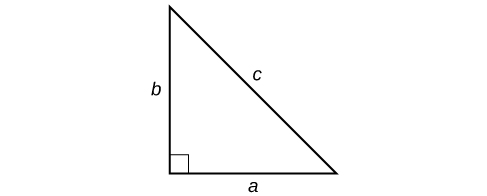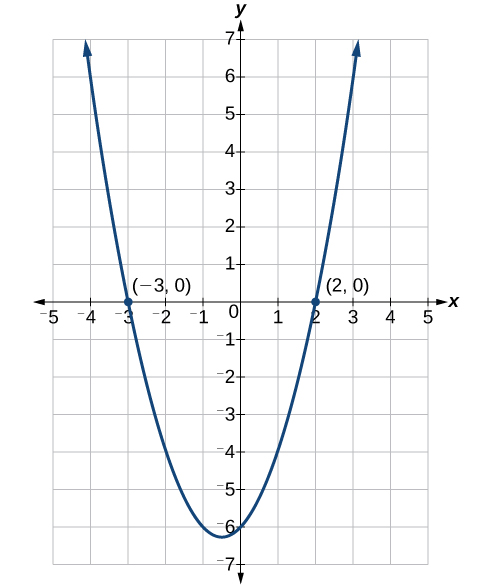Learning Outcomes
By the end of this section, you will be able to:
- Factor a quadratic equation to solve it.
- Use the square root property to solve a quadratic equation.
- Use the Pythagorean Theorem and the square root property to find the unknown length of the side of a right triangle.
- Complete the square to solve a quadratic equation.
- Use the quadratic formula to solve a quadratic equation.
- Use the discriminant to determine the number and type of solutions to a quadratic equation.
The left computer monitor in the image below is a 23.6-inch model and the one on the right is a 27-inch model. Proportionally, the monitors appear very similar. If there is a limited amount of space and we desire the largest monitor possible, how do we decide which one to choose? In this section, we will learn how to solve problems such as this using four different methods.

Factoring and the Square Root Property
An equation containing a second-degree polynomial is called a quadratic equation. For example, equations such as [latex]2{x}^{2}+3x - 1=0[/latex] and [latex]{x}^{2}-4=0[/latex] are quadratic equations. They are used in countless ways in the fields of engineering, architecture, finance, biological science, and, of course, mathematics.
Often the easiest method of solving a quadratic equation is factoring. Factoring means finding expressions that can be multiplied together to give the expression on one side of the equation.
If a quadratic equation can be factored, it is written as a product of linear terms. Solving by factoring depends on the zero-product property which states that if [latex]a\cdot b=0[/latex], then [latex]a=0[/latex] or [latex]b=0[/latex], where a and b are real numbers or algebraic expressions. In other words, if the product of two numbers or two expressions equals zero, then one of the numbers or one of the expressions must equal zero because zero multiplied by anything equals zero.
Multiplying the factors expands the equation to a string of terms separated by plus or minus signs. So, in that sense, the operation of multiplication undoes the operation of factoring. For example, expand the factored expression [latex]\left(x - 2\right)\left(x+3\right)[/latex] by multiplying the two factors together.
The product is a quadratic expression. Set equal to zero, [latex]{x}^{2}+x - 6=0[/latex] is a quadratic equation. If we were to factor the equation, we would get back the factors we multiplied.
The process of factoring a quadratic equation depends on the leading coefficient, whether it is 1 or another integer. We will look at both situations; but first, we want to confirm that the equation is written in standard form, [latex]a{x}^{2}+bx+c=0[/latex], where a, b, and c are real numbers and [latex]a\ne 0[/latex]. The equation [latex]{x}^{2}+x - 6=0[/latex] is in standard form.
We can use the zero-product property to solve quadratic equations in which we first have to factor out the greatest common factor (GCF), and for equations that have special factoring formulas as well, such as the difference of squares, both of which we will see later in this section.
A General Note: The Zero-Product Property and Quadratic Equations
The zero-product property states
where a and b are real numbers or algebraic expressions.
A quadratic equation is an equation containing a second-degree polynomial; for example
where a, b, and c are real numbers, and [latex]a\ne 0[/latex]. It is in standard form.
Solving Quadratics with a Leading Coefficient of 1
In the quadratic equation [latex]{x}^{2}+x - 6=0[/latex], the leading coefficient, or the coefficient of [latex]{x}^{2}[/latex], is 1. We have one method of factoring quadratic equations in this form.
How To: Given a quadratic equation with the leading coefficient of 1, factor it
- Find two numbers whose product equals c and whose sum equals b.
- Use those numbers to write two factors of the form [latex]\left(x+k\right)\text{ or }\left(x-k\right)[/latex], where k is one of the numbers found in step 1. Use the numbers exactly as they are. In other words, if the two numbers are 1 and [latex]-2[/latex], the factors are [latex]\left(x+1\right)\left(x - 2\right)[/latex].
- Solve using the zero-product property by setting each factor equal to zero and solving for the variable.
Example: Factoring and Solving a Quadratic with Leading Coefficient of 1
Factor and solve the equation: [latex]{x}^{2}+x - 6=0[/latex].
Try It
Factor and solve the quadratic equation: [latex]{x}^{2}-5x - 6=0[/latex].
Using the Square Root Property
When there is no linear term in the equation, another method of solving a quadratic equation is by using the square root property, in which we isolate the [latex]{x}^{2}[/latex] term and take the square root of the number on the other side of the equal sign. Keep in mind that sometimes we may have to manipulate the equation to isolate the [latex]{x}^{2}[/latex] term so that the square root property can be used.
A General Note: The Square Root Property
With the [latex]{x}^{2}[/latex] term isolated, the square root propty states that:
where k is a nonzero real number.
How To: Given a quadratic equation with an [latex]{x}^{2}[/latex] term but no [latex]x[/latex] term, use the square root property to solve it
- Isolate the [latex]{x}^{2}[/latex] term on one side of the equal sign.
- Take the square root of both sides of the equation, putting a [latex]\pm[/latex] sign before the expression on the side opposite the squared term.
- Simplify the numbers on the side with the [latex]\pm[/latex] sign.
Example: Solving a Simple Quadratic Equation Using the Square Root Property
Solve the quadratic using the square root property: [latex]{x}^{2}=8[/latex].
Example: Solving a Quadratic Equation Using the Square Root Property
Solve the quadratic equation: [latex]4{x}^{2}+1=7[/latex]
Try It
Solve the quadratic equation using the square root property: [latex]3{\left(x - 4\right)}^{2}=15[/latex].
Using the Pythagorean Theorem
One of the most famous formulas in mathematics is the Pythagorean Theorem. It is based on a right triangle and states the relationship among the lengths of the sides as [latex]{a}^{2}+{b}^{2}={c}^{2}[/latex], where [latex]a[/latex] and [latex]b[/latex] refer to the legs of a right triangle adjacent to the [latex]90^\circ[/latex] angle, and [latex]c[/latex] refers to the hypotenuse. It has immeasurable uses in architecture, engineering, the sciences, geometry, trigonometry, and algebra, and in everyday applications.
We use the Pythagorean Theorem to solve for the length of one side of a triangle when we have the lengths of the other two. Because each of the terms is squared in the theorem, when we are solving for a side of a triangle, we have a quadratic equation. We can use the methods for solving quadratic equations that we learned in this section to solve for the missing side.
The Pythagorean Theorem is given as
where [latex]a[/latex] and [latex]b[/latex] refer to the legs of a right triangle adjacent to the [latex]{90}^{\circ }[/latex] angle, and [latex]c[/latex] refers to the hypotenuse.

Example: Finding the Length of the Missing Side of a Right Triangle
Find the length of the missing side of the right triangle.

Try It
Use the Pythagorean Theorem to solve the right triangle problem: Leg a measures 4 units, leg b measures 3 units. Find the length of the hypotenuse.
Completing the Square and the Quadratic Formula
Not all quadratic equations can be factored or can be solved in their original form using the square root property. In these cases, we may use a method for solving a quadratic equation known as completing the square. Using this method, we add or subtract terms to both sides of the equation until we have a perfect square trinomial on one side of the equal sign. We then apply the square root property. To complete the square, the leading coefficient, a, must equal 1. If it does not, then divide the entire equation by a. Then, we can use the following procedures to solve a quadratic equation by completing the square.
We will use the example [latex]{x}^{2}+4x+1=0[/latex] to illustrate each step.
- Given a quadratic equation that cannot be factored and with [latex]a=1[/latex], first add or subtract the constant term to the right sign of the equal sign.
[latex]{x}^{2}+4x=-1[/latex]
- Multiply the b term by [latex]\frac{1}{2}[/latex] and square it.
[latex]\begin{array}{l}\frac{1}{2}\left(4\right)=2\hfill \\ {2}^{2}=4\hfill \end{array}[/latex]
- Add [latex]{\left(\frac{1}{2}b\right)}^{2}[/latex] to both sides of the equal sign and simplify the right side. We have
[latex]\begin{array}{l}{x}^{2}+4x+4=-1+4\hfill \\ {x}^{2}+4x+4=3\hfill \end{array}[/latex]
- The left side of the equation can now be factored as a perfect square.
[latex]\begin{array}{l}{x}^{2}+4x+4=3\hfill \\ {\left(x+2\right)}^{2}=3\hfill \end{array}[/latex]
- Use the square root property and solve.
[latex]\begin{array}{l}\sqrt{{\left(x+2\right)}^{2}}=\pm \sqrt{3}\hfill \\ x+2=\pm \sqrt{3}\hfill \\ x=-2\pm \sqrt{3}\hfill \end{array}[/latex]
- The solutions are [latex]x=-2+\sqrt{3}[/latex], [latex]x=-2-\sqrt{3}[/latex].
Example: Solving a Quadratic by Completing the Square
Solve the quadratic equation by completing the square: [latex]{x}^{2}-3x - 5=0[/latex].
Try It
Solve by completing the square: [latex]{x}^{2}-6x=13[/latex].
Using the Quadratic Formula
The fourth method of solving a quadratic equation is by using the quadratic formula, a formula that will solve all quadratic equations. Although the quadratic formula works on any quadratic equation in standard form, it is easy to make errors in substituting the values into the formula. Pay close attention when substituting, and use parentheses when inserting a negative number.
We can derive the quadratic formula by completing the square. We will assume that the leading coefficient is positive; if it is negative, we can multiply the equation by [latex]-1[/latex] and obtain a positive a. Given [latex]a{x}^{2}+bx+c=0[/latex], [latex]a\ne 0[/latex], we will complete the square as follows:
- First, move the constant term to the right side of the equal sign:
[latex]a{x}^{2}+bx=-c[/latex]
- As we want the leading coefficient to equal 1, divide through by a:
[latex]{x}^{2}+\frac{b}{a}x=-\frac{c}{a}[/latex]
- Then, find [latex]\frac{1}{2}[/latex] of the middle term, and add [latex]{\left(\frac{1}{2}\frac{b}{a}\right)}^{2}=\frac{{b}^{2}}{4{a}^{2}}[/latex] to both sides of the equal sign:
[latex]{x}^{2}+\frac{b}{a}x+\frac{{b}^{2}}{4{a}^{2}}=\frac{{b}^{2}}{4{a}^{2}}-\frac{c}{a}[/latex]
- Next, write the left side as a perfect square. Find the common denominator of the right side and write it as a single fraction:
[latex]{\left(x+\frac{b}{2a}\right)}^{2}=\frac{{b}^{2}-4ac}{4{a}^{2}}[/latex]
- Now, use the square root property, which gives
[latex]\begin{array}{l}x+\frac{b}{2a}=\pm \sqrt{\frac{{b}^{2}-4ac}{4{a}^{2}}}\hfill \\ x+\frac{b}{2a}=\frac{\pm \sqrt{{b}^{2}-4ac}}{2a}\hfill \end{array}[/latex]
- Finally, add [latex]-\frac{b}{2a}[/latex] to both sides of the equation and combine the terms on the right side. Thus,
[latex]x=\frac{-b\pm \sqrt{{b}^{2}-4ac}}{2a}[/latex]
A General Note: The Quadratic Formula
Written in standard form, [latex]a{x}^{2}+bx+c=0[/latex], any quadratic equation can be solved using the quadratic formula:
where a, b, and c are real numbers and [latex]a\ne 0[/latex].
How To: Given a quadratic equation, solve it using the quadratic formula
- Make sure the equation is in standard form: [latex]a{x}^{2}+bx+c=0[/latex].
- Make note of the values of the coefficients and constant term, [latex]a,b[/latex], and [latex]c[/latex].
- Carefully substitute the values noted in step 2 into the equation. To avoid needless errors, use parentheses around each number input into the formula.
- Calculate and solve.
Example: Solve the Quadratic Equation Using the Quadratic Formula
Solve the quadratic equation: [latex]{x}^{2}+5x+1=0[/latex].
Example: Solving a Quadratic Equation with the Quadratic Formula
Use the quadratic formula to solve [latex]{x}^{2}+x+2=0[/latex].
. Notice they are written in standard form of a complex number. When a solution is a complex number, you must separate the real part from the imaginary part and write it in standard form.
Try It
Solve the quadratic equation using the quadratic formula: [latex]9{x}^{2}+3x - 2=0[/latex].
The Discriminant
The quadratic formula not only generates the solutions to a quadratic equation, it tells us about the nature of the solutions when we consider the discriminant, or the expression under the radical, [latex]{b}^{2}-4ac[/latex]. The discriminant tells us whether the solutions are real numbers or complex numbers as well as how many solutions of each type to expect. The table below relates the value of the discriminant to the solutions of a quadratic equation.
| Value of Discriminant | Results |
|---|---|
| [latex]{b}^{2}-4ac=0[/latex] | One rational solution (double solution) |
| [latex]{b}^{2}-4ac>0[/latex], perfect square | Two rational solutions |
| [latex]{b}^{2}-4ac>0[/latex], not a perfect square | Two irrational solutions |
| [latex]{b}^{2}-4ac<0[/latex] | Two complex solutions |
A General Note: The Discriminant
For [latex]a{x}^{2}+bx+c=0[/latex], where [latex]a[/latex], [latex]b[/latex], and [latex]c[/latex] are real numbers, the discriminant is the expression under the radical in the quadratic formula: [latex]{b}^{2}-4ac[/latex]. It tells us whether the solutions are real numbers or complex numbers and how many solutions of each type to expect.
Example: Using the Discriminant to Find the Nature of the Solutions to a Quadratic Equation
Use the discriminant to find the nature of the solutions to the following quadratic equations:
- [latex]{x}^{2}+4x+4=0[/latex]
- [latex]8{x}^{2}+14x+3=0[/latex]
- [latex]3{x}^{2}-5x - 2=0[/latex]
- [latex]3{x}^{2}-10x+15=0[/latex]
Try It
Key Concepts
- Many quadratic equations can be solved by factoring when the equation has a leading coefficient of 1 or if the equation is a difference of squares. The zero-factor property is then used to find solutions.
- Many quadratic equations with a leading coefficient other than 1 can be solved by factoring using the grouping method.
- Another method for solving quadratics is the square root property. The variable is squared. We isolate the squared term and take the square root of both sides of the equation. The solution will yield a positive and negative solution.
- Completing the square is a method of solving quadratic equations when the equation cannot be factored.
- A highly dependable method for solving quadratic equations is the quadratic formula based on the coefficients and the constant term in the equation.
- The discriminant is used to indicate the nature of the solutions that the quadratic equation will yield: real or complex, rational or irrational, and how many of each.
- The Pythagorean Theorem, among the most famous theorems in history, is used to solve right-triangle problems and has applications in numerous fields. Solving for the length of one side of a right triangle requires solving a quadratic equation.
Glossary
- completing the square
- a process for solving quadratic equations in which terms are added to or subtracted from both sides of the equation in order to make one side a perfect square
- discriminant
- the expression under the radical in the quadratic formula that indicates the nature of the solutions, real or complex, rational or irrational, single or double roots.
- Pythagorean Theorem
- a theorem that states the relationship among the lengths of the sides of a right triangle, used to solve right triangle problems
- quadratic equation
- an equation containing a second-degree polynomial; can be solved using multiple methods
- quadratic formula
- a formula that will solve all quadratic equations
- square root property
- one of the methods used to solve a quadratic equation in which the [latex]{x}^{2}[/latex] term is isolated so that the square root of both sides of the equation can be taken to solve for x
- zero-product property
- the property that formally states that multiplication by zero is zero so that each factor of a quadratic equation can be set equal to zero to solve equations
Candela Citations
- Revision and Adaptation. Provided by: Lumen Learning. License: CC BY: Attribution
- College Algebra. Authored by: Abramson, Jay et al.. Provided by: OpenStax. Located at: http://cnx.org/contents/9b08c294-057f-4201-9f48-5d6ad992740d@5.2. License: CC BY: Attribution. License Terms: Download for free at http://cnx.org/contents/9b08c294-057f-4201-9f48-5d6ad992740d@5.2
- Question ID 2029. Authored by: Lawrence Morales. License: CC BY: Attribution. License Terms: IMathAS Community License CC-BY + GPL
- Question 29172, 35145. Authored by: Jim Smart. License: CC BY: Attribution. License Terms: IMathAS Community License CC-BY + GPL
- Question ID 48710. Authored by: Darlene Diaz. License: CC BY: Attribution. License Terms: IMathAS Community License CC-BY + GPL
- Question ID 1384. Authored by: WebWork-Rochester. License: CC BY: Attribution. License Terms: IMathAS Community License CC-BY + GPL
- Question ID 79619. Authored by: Edward Wicks. License: CC BY: Attribution. License Terms: IMathAS Community License CC-BY + GPL
